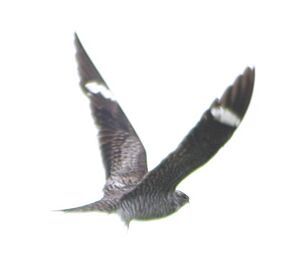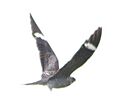Common nighthawk facts for kids
Quick facts for kids Common nighthawk |
|
|---|---|
 |
|
| Conservation status | |
| Scientific classification | |
| Genus: |
Chordeiles
|
| Species: |
minor
|
| Subspecies | |
|
See text |
|
 |
|
| Synonyms | |
|
Caprimulgus minor |
|
The common nighthawk (also called bullbat) is a medium-sized bird found in the Americas. It is active during dawn, dusk, or night. This bird belongs to the nightjar family. You can often tell it's around by its unique calls!
Common nighthawks are usually dark, with colors like gray, black, and brown. Their patterns help them blend in, making them hard to spot during the day. But when they fly, they are easy to see. They fly in a bouncy, zigzag way. A cool thing about them is their tiny beak, which hides a very wide mouth! Some people think they look a bit like owls.
These birds don't spend much time on the ground. They have short legs and prefer to perch flat on branches, posts, or roofs. Male nighthawks might roost together, but usually, they are solitary birds.
Common nighthawks have a large, flat head with big eyes. They don't have stiff feathers around their mouth like some other birds. Their wings are long and thin, reaching past their notched tail when they are resting. You can also see white patches on their wings and stripes on their sides.
A common nighthawk is about 22 to 25 cm (8.7 to 9.8 in) long. Its wings can spread 51 to 61 cm (20 to 24 in) wide. They weigh between 55 to 98 g (1.9 to 3.5 oz). These birds usually live for 4 to 5 years.
Contents
Cool Names and What They Mean
The name Chordeiles comes from old Greek words. Khoreia means "a dance with music" and deile means "evening." The word minor is Latin for "smaller."
The name "nighthawk" was first used in England for a different bird, the European nightjar. But in the Americas, people started using it for this bird in the late 1700s.
Sometimes, the common nighthawk is called a "bull-bat." This is because its flight looks a bit like a bat's. Also, when it dives, its wings make a loud "boom" sound, like a bull.
These birds, and other nightjars, are also called "bugeaters." This is because they eat a lot of insects! The common nighthawk is probably why Nebraska was once known as the "Bugeater State." Even some sports teams there were called the Bugeaters!
About Their Family and Types
Common nighthawks belong to the nightjar family, called Caprimulgidae. Within this family, nighthawks are special because they don't have stiff feathers around their mouths.
For a long time, people thought the common nighthawk and the whip-poor-will were the same bird. But in the early 1800s, a famous bird expert named Alexander Wilson figured out they were different species.
Different Kinds of Nighthawks
There are 9 different types, or subspecies, of common nighthawks. They look a bit different depending on where they live. For example, some are darker, and some are paler. One type, called C. m. henryi, has unique cinnamon-colored feather edges.
How to Spot a Common Nighthawk
You can tell a common nighthawk apart from other similar birds by a few things:
- Its tail is forked, and males have a white bar on it.
- Its wings are long, pointed, and have clear white patches.
- It doesn't have stiff feathers around its mouth.
- Most importantly, listen for its unique calls!
These birds are about 21 to 25 cm (8.3 to 9.8 in) long. Their wingspan is 51 to 61 cm (20 to 24 in). They weigh about 55 to 98 g (1.9 to 3.5 oz).
It can be tricky to tell common nighthawks apart from the Antillean nighthawk and the lesser nighthawk. The lesser nighthawk is smaller and has more buffy colors under its tail. Common nighthawks also fly higher when they hunt. The best way to tell the Antillean nighthawk apart is by its call.
Where They Live and Travel
Common nighthawks can live in many places. You can find them in forests, deserts, grasslands, cities, and even on beaches. They live from sea level up to 3,000 m (9,800 ft) high. They like to nest in open areas like clearings or burned parts of forests. They are even drawn to cities because of all the insects there!
The common nighthawk is the only nighthawk species found in most of northern North America. They need a lot of food, so they move to places where insects are plentiful.
Amazing Migration!
Common nighthawks are incredible travelers! They can fly between 2,500 to 6,800 kilometres (1,600 to 4,200 mi) during their migration. They travel during the day or night in large, loose groups, sometimes with thousands of birds! This long journey is one of the longest migrations for birds in North America.
They start flying north in late February and arrive at their breeding spots by mid-June. Then, they start flying south in mid-July and finish their journey by early October.
During migration, these birds fly through Central America, Florida, the Caribbean, and Bermuda. They spend their winter in South America, mostly in Argentina. As they fly, they eat insects. They often gather to hunt near marshes, rivers, and lakes. In some places, people see them most often in the late afternoon and evening, especially around sunset.
Sometimes, they fly closer to the ground during migration, probably to find more insects. They might also feed at higher altitudes.
It's hard to know exactly where common nighthawks spend the winter in South America. This is because they look very similar to the lesser nighthawk. But records show they spend winters in countries like Ecuador, Peru, Bolivia, Brazil, Paraguay, Uruguay, and Argentina.
How They Behave
Their Calls and Sounds
The common nighthawk has a very clear call. It sounds like a nasal peent or beernt when they fly. They call most often about 30 to 45 minutes after the sun sets.
During courtship, male nighthawks make a croaking auk auk auk sound when a female is nearby. Males also make a special "boom" sound. They do this by diving quickly and letting air rush through their wing feathers.
If someone gets too close to their nest, females make a harsh rasping sound. Males will clap their wings together. Males are very protective of their territory. They will dive at other birds, humans, or even raccoons if they feel threatened.
What They Eat
Common nighthawks are expert flyers. They hunt for insects while flying for long periods, often high up or in open areas. They prefer to eat flying insects during dawn and dusk. They rarely hunt in complete darkness, even on bright moonlit nights.
They are not picky eaters, but they do seem to prefer certain insects. They like to eat beetles, bees, ants, and wasps. While butterflies and moths are common in their diet, they try to avoid flies.
Nighthawks likely use their eyesight to find food. There's no proof they use echolocation (like bats). They have been seen gathering around artificial lights to catch insects attracted to the light. Common nighthawks fly at an average speed of 23.4 km/h (14.5 mph).
Drinking Water
Common nighthawks have been seen drinking water while flying. They fly very low over the surface of the water to take a drink.
Nesting and Babies
Common nighthawks breed from mid-March to early October. They usually have one group of babies (brood) per season, but sometimes they have two. It's believed they breed every year. Females have been known to use the same nesting spots in different years. They also seem to stay with one partner (monogamous).
Males try to attract females by diving and making their "boom" sound. The female might be flying or sitting on the ground. When they are ready to mate, the male will rock his body, wag his tail, and make gurgling sounds.
They don't build a fancy nest. Instead, they lay their eggs directly on bare rock, gravel, or sometimes on moss. They prefer nesting in forests with rocky areas, clearings, or sandy patches. In cities, they sometimes nest on flat gravel rooftops.
Nighthawks are solitary nesters. They keep a good distance from other nighthawk pairs. However, they might nest closer to other types of birds.
Females choose the nest site and do most of the egg incubation. Males will sometimes help. The eggs hatch in about 18 days. The female leaves the nest at night to find food. The male guards the nest from a nearby tree, diving or hissing at intruders. Nighthawks usually don't abandon their nests easily. They rely on their camouflage to stay hidden. If they do leave, the female might hiss or try to distract the intruder.
Eggs, Hatching, and Young Birds
Common nighthawk eggs are oval-shaped, strong, and have many speckles. The female lays two eggs, each weighing about 6–7 g (0.21–0.25 oz). The eggs are laid over one or two days.
You might hear the chicks peeping before they hatch. Once they hatch, the mother removes the eggshells to keep predators away. She might carry them away or even eat some of them! Newborn chicks are active and have their eyes fully or partly open. They are covered in soft, fluffy feathers.
By their second day, the chicks double in weight! They can also move towards their mother when she calls. If an intruder comes near, the young birds will hiss.
The young birds are fed by their parents who bring up (regurgitate) food for them. This happens before sunrise and after sunset. The male helps feed the young birds and also feeds the female during nesting.
The young birds take their first flight around 18 days old. By 25–30 days, they are flying well. They are usually last seen with their parents around day 30. They are fully grown by 45–50 days. Around day 52, the young bird might join a flock and start migrating. Young nighthawks are lighter in color and have smaller white wing patches than adult birds.
Who Hunts Nighthawks?
Because nighthawks nest on the ground, their eggs and young are in danger from animals like skunks, raccoons, and opossums. Adult nighthawks can be hunted by domestic cats, golden eagles, and great horned owls. Peregrine falcons have also tried to hunt them. Other animals that might hunt them include dogs, coyotes, foxes, other hawks, American kestrels, crows and ravens, and snakes.
Their Status and How We Protect Them
The number of common nighthawks in North America has generally gone down. However, in some areas, their numbers have increased. Because they live over such a large area, it's hard to know the exact risk in each region. In Ontario, Canada, the common nighthawk is considered a species of special concern.
Since they nest on the ground, common nighthawks are easily caught by predators. These include domestic cats, ravens, snakes, dogs, coyotes, falcons, and owls.
Several things cause their decline:
- Fewer flat roofs (which they use for nesting)
- Pesticides (which reduce their insect food)
- More predators
- Loss of their natural homes
Other possible reasons for their decline include climate change, diseases, being hit by cars, tall towers (which are flying hazards), and parasites.
To help them, people have tried adding gravel pads to rubberized roofs in cities. This helps, as nighthawks have been seen nesting there.
Images for kids








